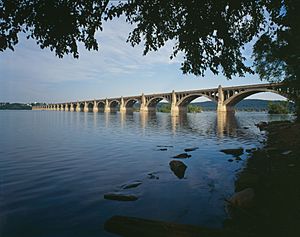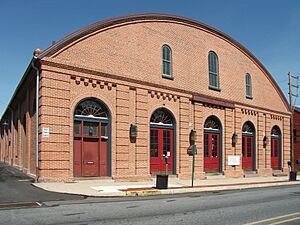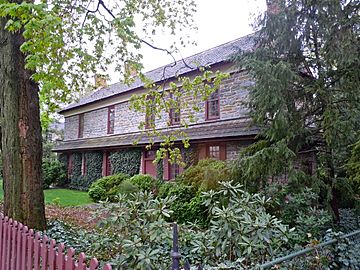Columbia, Pennsylvania facts for kids
Quick facts for kids
Columbia, Pennsylvania
|
|||
|---|---|---|---|
|
Borough
|
|||

|
|||
|
|||

Location of Columbia in Lancaster County, Pennsylvania
|
|||
| Country | United States | ||
| State | Pennsylvania | ||
| County | Lancaster | ||
| Area | |||
| • Total | 2.42 sq mi (6.27 km2) | ||
| • Land | 2.41 sq mi (6.25 km2) | ||
| • Water | 0.01 sq mi (0.02 km2) | ||
| Elevation | 361 ft (110 m) | ||
| Population
(2020)
|
|||
| • Total | 10,207 | ||
| • Density | 4,228.25/sq mi (1,632.61/km2) | ||
| Time zone | UTC-5 (EST) | ||
| • Summer (DST) | UTC-4 (EDT) | ||
| ZIP Code |
17512
|
||
| Area code(s) | 717 and 223 | ||
Columbia, once known as Wright's Ferry, is a town in Lancaster County, Pennsylvania, United States. In 2020, about 10,222 people lived there. It is about 28 miles (45 km) southeast of Harrisburg. Columbia is on the east side of the Susquehanna River, across from Wrightsville.
The town was started in 1726 by English Quakers. They were led by John Wright. He started Wright's Ferry, which was the first way to cross the Susquehanna River in this area. This ferry helped the town grow. Columbia almost became the capital of the United States!
Later, during the American Civil War, Columbia faced some challenges. But it remained a busy place for travel and factories in the 1800s. It was even the end point of the Pennsylvania Canal. However, the Great Depression and new technologies caused the town to decline. Today, Columbia is known for having one of the few museums in the world dedicated to horology, which is the study of time and clocks.
Contents
History of Columbia
Early Beginnings
The land where Columbia is now was first home to Native American tribes. The Susquehannocks were a main tribe. They moved to this area between 1575 and 1600. They had villages south of Columbia.
First European Settlers
In 1724, John Wright, an English Quaker, came to the Columbia area. He wanted to explore the land and talk to the Shawnee tribe. The Shawnee had a settlement along Shawnee Creek. Wright built a log cabin and stayed for over a year. This area was then called "Shawanatown."
Wright returned in 1726 with Robert Barber and Samuel Blunston. They started to develop the area. Wright built a house near the Susquehanna River. Susanna Wright, his relative, later built Wright's Ferry Mansion in 1738. This is the oldest house still standing in Columbia. You can visit it as a museum today.
Robert Barber built a sawmill in 1727. He also built a home near the river. This home is the second oldest in Columbia. Samuel Blunston built a large house called Bellmont. It was on a hill near North Second Street. He left it to Susanna Wright when he died. This house was taken down in the 1920s to build a bridge.
In 1729, Lancaster County was created. It was formed from parts of Chester County. People often visited Wright's home for official business. Many Pennsylvania Dutch settlers moved to the area. During this time, the town was known as "Wright's Ferry."
The Famous Wright's Ferry
In 1730, John Wright got permission to run a ferry across the Susquehanna River. He started Wright's Ferry with Barber and Blunston. He also built a ferry house and a two-story tavern.
The first ferry boats were two dugout canoes tied together. They were pulled by cattle. Crossing the river could be dangerous. If the lead animal got confused, the others would follow it in circles. They could get tired and drown.
Ferry prices in the 1700s included:
- A coach with four people and five horses: nine shillings.
- A four-horse wagon: three shillings and nine pence.
- A person and a horse: six pence.
Prices went down in 1787 because of another ferry nearby. Wright's Ferry was located south of where the Veterans Memorial Bridge is today.
Many travelers from Lancaster and Philadelphia came through Columbia. They used the ferry to cross the Susquehanna. As more people traveled, the ferry grew. It began using canoes, rafts, flatboats, and even steamboats. It could carry large Conestoga wagons. Sometimes, there were long waits to cross the river. Ferry workers used chalk to number the wagons.
Early Conflicts
Wright's Ferry was the first easy way to cross the Susquehanna River. At that time, Maryland also claimed land in southern Pennsylvania. Maryland wanted to control the area around the ferry. A Maryland settler named Thomas Cresap tried to start his own ferry. This led to conflicts between Pennsylvania and Maryland. There were small fights and legal battles. The problem was finally solved in 1738. This helped set the border that later became the Mason–Dixon line.
Becoming Columbia
Samuel Wright, John Wright's grandson, was born in 1754. He became the owner of the town's land. He helped set up the town's first water distribution system. He also helped start the Washington Institute, which was the town's first school for higher learning.
In 1788, Samuel Wright planned out the town into 160 building lots. He sold them by lottery. Wright and the town citizens renamed the town "Columbia." They did this to honor Christopher Columbus. They hoped the new United States Congress would choose Columbia as the nation's capital. George Washington liked this idea. A formal proposal was made in 1789. But in 1790, Columbia lost by just one vote. Later, Columbia almost became the capital of Pennsylvania. But Harrisburg was chosen instead because it was closer to the state's center.
The 1800s: Growth and Change
Over time, more people from different backgrounds moved to Columbia. These included English, Scots-Irish, German, and French settlers. Also, many freed African slaves moved to the area.
Columbia became an official town (borough) in 1814. In the same year, the world's longest covered bridge was built. It crossed the Susquehanna to Wrightsville. This made it easier to cross the river. The bridge was 5,690 feet (1,734 m) long. It had 54 stone supports. This bridge was destroyed by bad weather in 1832. A new covered bridge was built within two years.
Public Works and Transportation
In 1826, Pennsylvania planned a big project called the Main Line of Public Works. The goal was to connect Pennsylvania using water travel. This included building a canal along the Susquehanna River. This canal would help boats avoid fast-moving water. The Pennsylvania Canal started operating in 1833. It began in Columbia and went 40 miles (64 km) north.
The plan also included building a new type of transportation: a railroad. This was the Philadelphia and Columbia Railroad. It was one of the first commercial railways in the United States. Today, parts of this railway are still used.
Canal boats were often seen at the Bruner coal wharf. The canal was supposed to go south from Columbia. But local landowners did not agree. Instead, a special path was built on the bridge. Boats could be pulled across the river using horses and mules. These boats then connected to another canal that went to Baltimore. Canals could not be used in winter because of ice and floods. This, along with the rise of railroads, led to the decline of canals. The Columbia Canal closed in 1901.
Columbia also became a stop on the Underground Railroad. This was a secret network that helped enslaved people escape to freedom. They were taken across the Susquehanna River. They were given food and supplies on their way north to other states and Canada.
In 1834, there was a disagreement between groups of workers in Columbia. This led to some African American residents being forced from their homes. Their property was also damaged.
In 1834, another bridge was built. This bridge was also the world's longest covered bridge. In the same year, the first railway line linking Columbia and Philadelphia opened. This became part of the Pennsylvania Railroad.
By 1852, regular train service connected Columbia to Baltimore, Philadelphia, Pittsburgh, and Harrisburg. This made Columbia an important business center.
The Civil War Era
In 1863, during the American Civil War, some local Black citizens joined the 54th Massachusetts Infantry. This was a famous group of Black soldiers. Other local people fought in different regiments. Some of these veterans are buried in a cemetery near Fifth Street.
On June 28, 1863, during the Gettysburg campaign, the covered bridge was burned. Residents of Columbia and the Pennsylvania state militia burned it. They did this to stop Confederate soldiers from entering Lancaster County. General Robert E. Lee wanted to attack Harrisburg and destroy railroads. General John B. Gordon was ordered to burn the bridge. But he hoped to capture it instead. Union forces had to burn it to stop the Confederates. The owners of the bridge asked for money for many years but were not paid back.
The burning of the bridge stopped one of Lee's plans. General Gordon later said that the fight at Wrightsville made the Confederates think the Union forces were weak. This idea carried over to the first day of the Battle of Gettysburg.
Growth After the War
After the bridge burned, a tugboat named Columbia pulled canal boats across the river. In 1868, another covered bridge was built. But a hurricane destroyed it in 1896. The next bridge was a steel bridge. It carried train tracks and a road for cars. It was taken down in 1964. But its stone supports can still be seen today. They are next to the Veterans Memorial Bridge. These supports are now used for "Flames Across the Susquehanna" events. These events re-enact the bridge burning.
In 1875, a new three-story town hall opened. It had an auditorium that could hold over 900 people. It was used as an opera house. The building also had offices and market stalls. A 140-foot (43 m) tall bell tower with a clock topped the building. The clock could be seen from all over town. Its bell could be heard far away. The building burned down in 1947. But it was rebuilt as a one-story municipal building that is still there today.
Trolley service started in 1893. This helped people travel to Lancaster and other nearby towns for work. Between 1830 and 1900, Columbia's population grew from 2,046 to 12,316.
Thriving Industries
By the mid-1800s, Columbia was a busy transportation center. It had a ferry, bridges, a canal, a railroad, and wharves. It was a major place for shipping lumber, coal, grain, pig iron, and people. Important industries included storing goods, processing tobacco, making iron, clockmaking, and boat building. Some famous local companies were the Ashley and Bailey Silk Mill and the Columbia Lace Mill.
From about 1854 to 1900, there were many factories in Columbia and nearby towns. These included 11 anthracite iron furnaces. These furnaces made pig iron. They used anthracite coal and hot air to melt iron ore. This process was very important in the iron industry at that time. Pennsylvania became a leader in iron production. Lancaster County also made a lot of pig iron.
The 1900s: Challenges and Changes
New Century, New Challenges
By 1900, Columbia's population was over 12,000. But the 1900s brought economic challenges. Local industries started to decline. The lumber industry disappeared as forests were used up. The iron furnaces closed when iron ores became scarce. The steel factories also stopped working. In 1906, the Pennsylvania Railroad opened a new facility somewhere else. This made Columbia's railroad less important. By 1920, the population had dropped by over 10%.
The Great Depression made Columbia's economy worse. Train service to the north and south was stopped. World War II created more jobs. But it did not bring long-term success to the town.
By 1960, the population was back to its 1900 level. In 1965, a study looked at Columbia's strengths and weaknesses. But its ideas were not followed. The Wright's Ferry Bridge, which opened in 1972, sent traffic around Columbia. This meant that Columbia did not experience the same growth as other towns in Lancaster County. By 2010, the population had grown slightly to 10,400.
Population Information
| Historical population | |||
|---|---|---|---|
| Census | Pop. | %± | |
| 1820 | 1,891 | — | |
| 1830 | 2,046 | 8.2% | |
| 1840 | 2,719 | 32.9% | |
| 1850 | 4,140 | 52.3% | |
| 1860 | 5,007 | 20.9% | |
| 1870 | 6,461 | 29.0% | |
| 1880 | 8,312 | 28.6% | |
| 1890 | 10,599 | 27.5% | |
| 1900 | 12,316 | 16.2% | |
| 1910 | 11,454 | −7.0% | |
| 1920 | 10,836 | −5.4% | |
| 1930 | 11,349 | 4.7% | |
| 1940 | 11,547 | 1.7% | |
| 1950 | 11,993 | 3.9% | |
| 1960 | 12,075 | 0.7% | |
| 1970 | 11,237 | −6.9% | |
| 1980 | 10,466 | −6.9% | |
| 1990 | 10,701 | 2.2% | |
| 2000 | 10,311 | −3.6% | |
| 2010 | 10,400 | 0.9% | |
| 2020 | 10,222 | −1.7% | |
| 2021 (est.) | 10,157 | −2.3% | |
| Sources: | |||
In 2000, there were 10,311 people living in Columbia. There were 4,287 households. About 28.3% of households had children under 18. The average household had 2.35 people. The average family had 3.01 people.
About 24.3% of the population was under 18. About 17.2% were 65 or older. The average age was 37 years. For every 100 females, there were about 89 males.
The median income for a household was $32,385. The median income for a family was $26,309. About 11.9% of the population lived below the poverty line. This included 18.3% of those under 18.
Geography and Climate
Columbia is in western Lancaster County. It is on the east side of the Susquehanna River. U.S. Route 30 goes through the northern part of town. This road leads east to Lancaster (11 miles or 18 km) and west to York (13 miles or 21 km). Harrisburg, the state capital, is about 30 miles (48 km) northwest. Pennsylvania Route 462 goes through the center of Columbia. It follows the old route of US 30.
Columbia covers about 2.42 square miles (6.27 square km). Most of this is land. A very small part is water.
The climate in Columbia has hot summers. Average monthly temperatures range from 30.9°F (-0.6°C) in January to 75.8°F (24.3°C) in July.
Museums and Historic Places
For over 50 years, Columbia has been home to the National Association of Watch and Clock Collectors (NAWCC). Their campus has a clock tower, a museum, a library, and a research center. They also have a "School of Horology" to train people to fix clocks and watches.
Other Interesting Sites
- Columbia Historic District
- Columbia Historic Preservation Society[1]
- Columbia Market House
- First National Bank Museum
- Wright's Ferry Mansion
- Bachman and Forry Tobacco Warehouse
- Columbia Wagon Works
- Old Columbia-Wrightsville Bridge
- Manor Street Elementary School
Schools in Columbia
Schools in Columbia are part of the Columbia Borough School District.
- Public Schools
- Park Elementary School
- Columbia Middle School (Taylor Campus and Hill Campus)
- Columbia High School
- Private schools
- Our Lady of the Angels (Kindergarten to 8th grade) is part of the Roman Catholic Diocese of Harrisburg. This school was formed in 1998 when Holy Trinity School and Saint Peter School joined together.
Historical Schools
- Cherry Street School
- Columbia Junior-Senior High School
- Holy Trinity School
- Manor Street School
- Poplar Street School
- St. Peter's School
- Taylor Elementary School
- Washington Institute
Notable People from Columbia
- Harriet Baker, an evangelist (someone who preaches religious messages)
- Ralph Heller Beittel, a composer (someone who writes music)
- Amelia Reynolds Long, an author (someone who writes books)
- Edward C. Shannon, a lieutenant governor of Pennsylvania
- Stephen Atkins Swails, a soldier and politician
- Thomas Welsh, a Civil War general
- Suzanne Westenhoefer, a comedian
- Dean Young, a poet (someone who writes poems)
See also
 In Spanish: Columbia (Pensilvania) para niños
In Spanish: Columbia (Pensilvania) para niños








